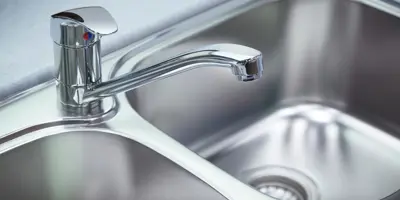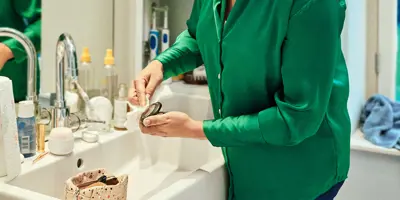4 people found this helpful

A piece of jewellery from a loved one will likely be kept with you for life, which means that silver necklace you’ve had round your neck for three years? Yep, that's probably encrusted with the ancient remains of slopped salsa dips, half-marathon sweats and spilled drinks. And that gold ring? Oh, the stories it could tell...
So, if that jewellery is with you every step of the way, you’ll need to know how to clean gold rings and what to clean silver with. Luckily, it’s super-easy to learn, so you don’t need to worry next time you mix something by hand and find your diamond ring has morphed into a dough-mond.
How to clean gold and silver jewellery with gemstones
If your jewellery has gemstones that are glued in, it’s important that you don’t submerge it in water. For example, if you’re cleaning silver earrings – the warm water might loosen the glue and send you hunting around for gems in your sink… Or worse – down the drain.
You’ll also need to avoid submerging some delicate gemstones that are held in place with fixings (like emerald or onyx), as they don’t like being submerged in water either. Here’s a safer cleaning method to try:
- Wipe the jewellery. Mix a small amount of mild washing up liquid with lukewarm water, dip a soft towel in it, and gently wipe the item.
- ‘Rinse’ the jewellery. Dampen a cloth with plain water and gently dab the item to soak up leftover residue.
- Leave to dry. Place your jewellery upside down to dry on an absorbent kitchen towel, so that any leftover water can drip out.
If your jewellery doesn’t have glued-in stones or delicate gemstones, then you can go about cleaning silver earrings and other items using the following methods.
How to clean gold the easy way
With a bit of elbow grease and a simple cleaning solution, you can get solid gold jewellery back to its best – rather than something that’s been found in archaeological dig. Here’s how to clean gold rings and other treasures with a DIY solution:
- Add a few drops of mild washing up liquid to a bowl of lukewarm water. Mix them together gently. And try to avoid hot water, which can crack precious stones like opals. But try not to use really cold water either as that can make the grime contract and become harder to shift. Tap water or sodium-free carbonated water works just fine.
- Soak the item. Let your jewellery sit in the solution for 15-30 minutes.
- Gently scrub with a very soft-bristled brush. Use up-and-down strokes. If you don’t have a specialist brush, you can use a soft, small toothbrush. Bear in mind that stiff bristles can remove gold plating, so only use this method on solid gold. Delicately work your way into the nooks and crannies – you might need to use a cotton bud too.
- Rinse under warm running water. Ensure the water flow is slow and gentle. And remember to put the plug in so that your jewellery doesn’t accidentally tumble down the plughole! You could also place the item in a fine-mesh metal sieve.
- Blot dry with a paper towel and leave to air dry. Don’t wear your jewellery until it’s completely dry, as you might trap moisture against your skin and irritate it.
How to clean silver to remove tarnish
Simply exposing your silver jewellery to light and air will tarnish it. That doesn’t mean you can only wear it on a spacewalk – you could use the above method for cleaning jewellery with glued-in or delicate gemstones – gently rub the item with a warm water and mild washing up liquid solution, wipe with plain water, and leave to air dry (or buff with a kitchen towel to dry, if there are no glued-in stones).
However, you could also try a specialist silver polish. This is best used on plain silver jewellery without any stones set in them:
- Add a small amount of the polish to a strong kitchen towel.
- Rub up and down (not in circular motions), turning the cloth to prevent the tarnish rubbing back on.
- Rinse with warm water.
- Buff with a dry kitchen towel.
Tip
To bring extra sparkle to your jewellery, buff it with kitchen roll that’s soft and strong. Plenty The Big One will hold together and do the job gently.
Other ways to clean gold and silver
If you've tried the classic tricks for shining up and cleaning silver earrings or giving your gold rings that mirror finish and they just aren't cutting it, why not roll up your sleeves and dive into something a bit unconventional?
So, if you're here because the old methods are as dull as a cloudy day, let’s get a little messy with some less traditional tactics:
- Clean and disinfect using vinegar. For a more vigorous clean, using vinegar can be very effective:
- Begin by covering your pan or sink with aluminium foil, then introduce one tablespoon of baking soda and one tablespoon of kosher salt into the foil-lined container.
- Next, pour 1/2 cup of distilled white vinegar into the mixture, triggering an effervescent reaction. To ensure complete submersion of your silver or gold pieces, carefully add one to two cups of boiling water.
- Arrange the items in a single layer within the dish. Allow lightly tarnished pieces to soak for approximately 30 seconds, while more heavily tarnished ones may require up to three minutes. Retrieve the items using tongs, ensuring they are dry, and conclude by buffing them to restore their shine.
- Use lemon to remove water spots. Unleash the tangy power of lemon to tackle those stubborn water spots. Add a few drops of concentrated lemon juice onto a microfiber cloth. Now, gently coax the sheen and shine back onto your favourite silver or gold pieces, watching each water spot disappear, washed away by a miniature citrus-scented wave. When not wearing your treasures, give them a respite in a cool, dry hideaway—away from the jostling and potential scrapes from their jewellery box companions. Imagine them resting, each piece having its own little bubble of space, safe and serene until their next outing.
- Polish using ketchup. Now, this one sounds a little ridiculous, and maybe a little delicious, but stick with us. The condiment can be used as a paste to polish tarnished metals, including silver.
- Restore shine with toothpaste. If it’s good enough for your teeth, it’s good enough for your jewels! Achieve a radiant sheen using toothpaste as a cleaning agent for your silver or gold items. Dilute a small amount of toothpaste with water, and using a soft cloth, gently polish the surfaces. Remember to rinse the silver or gold thoroughly afterwards. However, exercise caution and avoid using toothpaste on plated items, as it may cause damage to the finish due to potential corrosion.
Now you know how to clean silver and gold jewellery, you can look forward to restoring that beautiful shine and wearing it whenever you like (even when you’re doing something messy like kneading dough)! Just watch out for that cookie monster... We’ve heard he likes eating jewellery too!
Related articles
How to clean silverware until it dazzles
Getting the silverware out for a special occasion? It’s easy to learn how to clean silver cutlery with non-toxic ingredients. Click to find out more.

How to clean aluminium in 5 ways
Find out how to polish aluminium at home, with tips on cleaning aluminium pans, sinks and outdoor surfaces, and more. It’s time to sparkle!

How to descale and deep clean your trusty coffee machine
Read on for a quick and simple way of descaling the coffee machine with vinegar, as well as instructions on how to clean a coffee maker without vinegar.

How to clean stainless steel — without streaks, smudges, or scratches
Learn how to clean stainless steel with these easy-to-follow step-by-step instructions, including what cleaning supplies to use when washing stainless steel.

How to clean the hob that’s under a layer of burnt food
Click to discover how to clean a stainless-steel hob, plus electric and induction hobs – including top tips for cleaning cooker hob plates.

How to remove limescale around the house — gently
Want to know how to get rid of limescale gently? Discover two brilliant yet natural ways to remove limescale from taps, toilets and sinks here.


